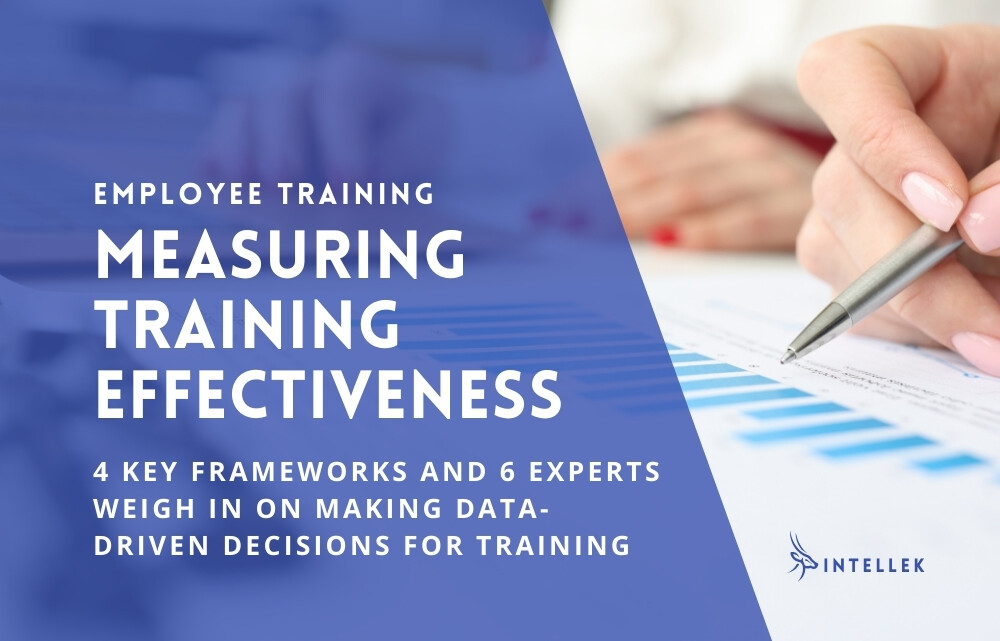

Training programs play a vital role in the success of any organization. They provide employees with the knowledge and skills they need to perform their jobs effectively and help companies stay competitive in a rapidly changing business environment.
But how can organizations determine if their training programs are actually successful? Besides using the most effective training delivery methods, the answer lies in metrics for measuring employee training effectiveness… Let’s dive into the topic of how to measure training effectiveness.
IN THIS ARTICLE...
How to Measure Training Effectiveness
Measuring training effectiveness is crucial for training administrators to evaluate the impact and success of their training programs. By using key metrics and indicators, they can assess the company’s model of learning evaluation and whether the training initiatives are achieving their intended goals and objectives, and making a positive difference in the organization.
Here are some essential ways to measure training effectiveness:
- Knowledge Acquisition: One fundamental aspect of training effectiveness is determining whether participants have gained the necessary knowledge and skills. This can be assessed through pre and post-training tests or evaluations that measure the increase in knowledge and understanding. The difference between the scores can indicate the effectiveness of the training in transferring knowledge to the participants.
- Skill Application: Knowledge is valuable when it can be practically applied in the workplace. Observing employees’ ability to apply newly acquired skills on the job is an effective measure of training effectiveness. This can be done through direct observation, job simulations, or practical assessments that evaluate the application of skills in real or simulated work scenarios.
- Performance Improvement: Training should ideally result in improved performance and productivity. Comparing key performance indicators (KPIs) before and after the training can help identify any positive changes. For instance, metrics such as sales figures, customer satisfaction ratings, or error rates can indicate whether the training has contributed to measurable improvements in performance.
- Behavior Change: Sometimes, the success of training lies in influencing employees’ behaviors and attitudes. This can be assessed through self-assessments, surveys, or feedback from supervisors and colleagues. By measuring changes in behavior, such as increased collaboration, better communication, or improved time management, training administrators can gauge the effectiveness of the program.
- Employee Engagement: Engaged employees are more likely to be receptive to training and apply the skills learned. Therefore, measuring employee engagement levels before and after training can provide insights into the effectiveness of the program. Surveys, interviews, or feedback sessions can be used to evaluate whether employees feel motivated, empowered, and supported as a result of the training.
- Return on Investment (ROI): Measuring the ROI of training helps assess the economic value generated by the program. This involves comparing the costs of training, including development, delivery, and participant time, with the benefits derived from improved performance, reduced turnover, or increased efficiency. Calculating the ROI provides a quantitative assessment of training effectiveness in terms of the organization’s financial gains.
- Participant Feedback: Gathering feedback directly from participants is essential to understanding their perception of the training and its impact. Surveys, focus groups, or interviews can capture participants’ opinions about the relevance, usefulness, and applicability of the training content. Their feedback can provide valuable insights for improving future training initiatives.
It is important to note that measuring training effectiveness is an ongoing process that requires a combination of quantitative and qualitative methods. Using a combination of these metrics can provide a comprehensive assessment of training effectiveness, allowing training administrators to make data-driven decisions and continuously improve their programs to meet organizational objectives.
Frameworks for Measuring Training Effectiveness
Kaufman’s Five Levels of Evaluation, Anderson’s Model for Learning Evaluation, Phillips ROI Model, and Kirkpatrick’s Model of Training Evaluation are some of the most popular training effectiveness statistical models for evaluating the effectiveness of L&D programs. These models provide a comprehensive framework for evaluating the impact of training on individuals, teams, and the company as a whole.
Kaufman’s Five Levels of Evaluation
Kaufman’s Five Levels of Evaluation is a model for evaluating the effectiveness of learning and development programs. It was developed by Roger Kaufman in the 1980s as a reaction to the limitations of Kirkpatrick’s Four Levels of Evaluation.
Kaufman’s model divides evaluation into five levels:
- Input – The first level assesses the quality of the resources used to support the learning experience, such as the training materials and the learning environment.
- Process – This level covers the acceptability and efficiency of the learning process, such as the delivery of the training and the participant’s satisfaction with the program.
- Individual – Level 3 looks at the impact of the learning on the individuals involved, such as their knowledge, skills, and attitudes.
- Small group – This level analyses the impact of the learning on small groups, such as teams and departments.
- Organization – The final level delves into the impact of the learning on the organization as a whole, such as its productivity and profitability.
Kaufman’s model is a comprehensive framework for evaluating the effectiveness of learning and development programs. It can be used by organizations of all sizes and in a variety of industries. If you are interested in learning more about Kaufman’s model, you can read the article Kaufman’s Model of Learning Evaluation: Key Concepts and Tutorial.
Anderson’s Model for Learning Evaluation
Another model to consider is Anderson’s Model for Learning Evaluation, this is a three-stage cycle that helps an organization determine the best training strategy for their needs. The three stages are:
- Determine the current alignment of training against strategic priorities for the organization. This stage evaluates how closely learning in your organization aligns with your organization’s strategic priorities—such as driving sales through training, increasing production, or reaching a new market.
- Use a range of methods to assess and evaluate the contribution of learning. This stage evaluates the contribution of learning to your organization via a range of measures.
- Establish the most relevant approaches for your organization.
The most relevant approach for any given organization will depend on its stakeholders’ goals and values. Anderson’s model suggests four categories of measure, as follows:
- Return on investment: This measure assesses the financial return on investment from learning and development programs.
- Learning function: This measure assesses the effectiveness of the learning function itself, such as its efficiency and its ability to meet the needs of the organization.
- Benchmarking: This measure compares the learning function to other organizations in the same industry.
- Capacity: This measure assesses the capacity of the learning function to meet the future needs of the organization.
Anderson’s model for learning evaluation is a versatile and comprehensive tool that can be utilized by institutions of all sizes and in a variety of industries. If you are interested in learning more about this model, watch this video…
Phillips ROI Model
The Phillips ROI Model is a method for evaluating the effectiveness of training programs. It is based on the idea that training should have a positive impact on the organization’s bottom line. The model identifies five levels of evaluation:
- Reaction. This level measures the participants’ satisfaction with the training program.
- Learning. This level measures the participants’ knowledge and skills gained from the training program.
- Application. This level measures the participants’ use of the knowledge and skills gained from the training program.
- Impact. This level measures the organization’s bottom-line results from the training program.
- Return on investment. This level calculates the return on investment from the training program.
This model is a valuable tool for evaluating the effectiveness of training programs. It can help organizations identify the areas where training is making a positive impact, and to make decisions about how to allocate resources for training in the future.
Phillips ROI Model has been criticized for being too simplistic and for not taking into account all of the factors that can affect the effectiveness of training programs. However, it remains a valuable tool for organizations that are looking to measure the impact of their training investments.
Kirkpatrick Model of Training Evaluation
The Kirkpatrick Model, developed by Donald Kirkpatrick in the 1950s, is a widely recognized training effectiveness statistical model. It consists of four levels of training evaluation, each focusing on a different aspect of the training program. These levels are:
- Level 1: Reaction – This level evaluates participants’ immediate reactions and satisfaction with the training. It involves collecting feedback through surveys, questionnaires, or focus groups to gauge participants’ perceptions of the training content, delivery, materials, and instructors. This level assesses factors such as engagement, relevance, and overall satisfaction.
- Level 2: Learning – Level 2 assesses the extent to which participants have acquired knowledge and skills during the training. It focuses on measuring the learning outcomes and whether participants have achieved the intended learning objectives. This can be done through tests, quizzes, skill demonstrations, or other forms of assessments administered before and after the training to measure knowledge gain or skills improvement.
- Level 3: Behavior – This level evaluates the transfer of learning from the training environment to the workplace. It assesses whether participants are applying the acquired knowledge and skills in their job roles. Observation, self-assessment, supervisor feedback, or performance evaluations can be used to measure behavior change and the practical application of new competencies on the job.
- Level 4: Results – The highest level of evaluation, Level 4, focuses on measuring the impact of training on organizational outcomes and goals. It assesses the tangible benefits that result from the training, such as increased productivity, improved quality, higher customer satisfaction, or reduced costs. Evaluating Level 4 involves analyzing key performance indicators (KPIs) and comparing data before and after the training to determine the training’s overall effectiveness and its contribution to organizational success.
Kirkpatrick’s Model emphasizes a sequential progression through the levels, with each level building upon the previous one. However, organizations may not always conduct evaluations at all four levels due to resource constraints or varying evaluation needs. Nevertheless, utilizing the Kirkpatrick Model provides a structured approach to training evaluation, enabling organizations to assess training effectiveness comprehensively and make informed decisions for continuous improvement.
Setting Goals for Measuring Training Effectiveness
Measuring the success of corporate training programs is essential to ensuring that training initiatives are achieving their desired outcomes and providing a return on investment.
Defining clear objectives and metrics is the first step in how to check the effectiveness of training. This involves identifying what outcomes you want to achieve and how you will measure them.
Here are some examples to help you identify your KPIs before the development phase of your training:
- Improve employee skills in a particular area, such as time management or problem-solving.
- Increase employee engagement and motivation.
- Improve employee performance and productivity.
- Enhance teamwork and collaboration among employees.
- Improve customer satisfaction through enhanced employee skills.
- Reduce errors and improve overall quality in the workplace.
- Promote professional development and career growth for employees.
- Implement new technologies, processes, or systems more effectively.
- Improve employee morale and job satisfaction.
- Enhance the reputation of the company in the industry.
By setting clear business goals and outcomes, you can ensure that your training initiatives are focused and effective, and provide a return on investment.
Assessing Retention and Transfer of Knowledge and Skills
One of the key metrics for measuring training effectiveness is tracking skills application in the workplace. This involves assessing the retention and transfer of knowledge and skills from training to the job.
For example, if your training program is designed to improve customer service, you can measure the impact by tracking customer satisfaction scores before and after the training program.
Evaluating the Impact of Training on Productivity and Success
Another important metric for calculating the effectiveness of training programs is tracking changes in job performance, productivity, and overall business outcomes.
For example, consider a law firm that provides training on project management and time-management techniques to its lawyers.
- Before the training, the law firm tracked the number of cases each lawyer handled per month and found that the average was 8 cases per lawyer.
- After the training, the average number of cases per lawyer increased to 12 cases per month, demonstrating an increase in productivity and overall business outcomes as a result of the training.
This type of data can be used to demonstrate the impact and measure the effectiveness of the training program and help the law firm make informed decisions about future training initiatives.
Utilizing Training Assessments to Gather Valuable Insights
Gathering feedback from participants is also crucial for measuring training success. Utilizing pre and post-training assessments, surveys, and interviews can provide valuable insights into the effectiveness of the training program and how it can be improved.
Learning Management Systems (LMS) are valuable tools for gathering participant feedback to measure the success of training programs. Utilizing pre and post-training assessments and surveys, LMSs provide a platform for collecting and analyzing data on participant attitudes, skills, and knowledge before and after training.
One way to use an LMS to gather feedback is to include pre-training assessments and surveys that ask participants about their current skills and knowledge related to the training content. This provides a baseline for measuring the impact of the training. After the training, post-training assessments and surveys can be used to measure the retention and transfer of knowledge and skills to the job.
LMSs can also be used to conduct cost-benefit analyses and calculate the financial impact and return on investment (ROI) of training programs. By tracking and analyzing data from pre and post-training assessments, LMSs can provide valuable insights into the effectiveness of training programs and help identify areas for improvement.
Additionally, LMSs can be used to gather qualitative data through participant feedback surveys, which can provide a more in-depth understanding of participant experiences and opinions about the training program. This information can be used to make adjustments to the training program to improve its impact and effectiveness.
Determining the Financial Impact and ROI of Training
In addition to these metrics for measuring training effectiveness, it is also important to conduct cost-benefit analyses to determine the financial impact and return on investment (ROI) of training. This involves calculating the cost of the training program and comparing it to the benefits it provides, such as increased productivity and improved job performance.
Download our free and vendor-agnostic LMS Evaluation eBook to find a useful tool that will help you establish the ROI of using an LMS to manage your training program.
Making Adjustments to Ensure Effective Training
To ensure that training programs are continually improving, it is essential to evaluate the effectiveness of different training methods and make adjustments as needed. This may involve changing the training methods, content, or delivery to better meet the needs of the learners.
Using Data to Drive Decisions and Improve Training
Continuously monitoring and analyzing training data is essential to inform future training decisions. This data (derived from learning and development metrics) can be used to drive the design, delivery, and evaluation of learning programs, and to demonstrate the value of learning and development to leadership.
Use Data to Drive Design, Delivery, and Evaluation
Using data to drive the design, delivery, and evaluation of learning programs involves utilizing data and feedback to inform and guide all aspects of the learning process.
This involves:
- Design: Collecting and analyzing data on the needs and current skills of the target audience to inform the design of the training program. This data can come from pre-training assessments, surveys, or even job analysis.
- Delivery: Using data and feedback from participants during training to make real-time adjustments to the content and delivery to ensure that the training is meeting the needs and expectations of the participants.
- Evaluation: Using data from pre and post-training assessments, surveys, and other sources to measure the impact and effectiveness of the training program. This data can be used to identify areas for improvement and inform future training decisions.
Continuous monitoring and analysis of training data is key to using data to drive the design, delivery, and evaluation of learning programs. This involves regularly collecting and analyzing data to track the impact of the training and identify areas for improvement.
The insights gained from this data can then be used to make evidence-based decisions about the design, delivery, and evaluation of future learning programs.
Demonstrating the Value of Learning and Development to Leadership
Demonstrating the value of learning and development to leadership involves presenting data and evidence to show the impact of training programs on business outcomes and ROI.
This can be done by:
- Tracking business outcomes: Collecting and presenting data on the impact of training programs on specific business outcomes, such as increased productivity, improved customer satisfaction, or increased sales.
- Calculating ROI: Calculating the return on investment (ROI) of training programs by comparing the cost of the training to the value generated by the improved business outcomes.
- Sharing participant feedback: Collecting and sharing feedback from participants on the impact of training programs on their skills and performance. This feedback can demonstrate the value of training to both the individual participants and the organization as a whole.
- Comparing to industry benchmarks: Comparing the results of your training programs to industry benchmarks to demonstrate how your organization is performing in comparison to others.
- Presenting data visually: Presenting data and evidence in an easy-to-understand and visually appealing way, such as through charts, graphs, and infographics, can help make the case for the value of learning and development to leadership.
By presenting data and evidence on the impact of training programs, leaders can understand the value that learning and development programs bring to the organization and make informed decisions about investment in these initiatives.


How Experts Measure Employee Training Effectiveness
Determining the impact of employee training programs is crucial for any business, CEOs and Founders are at the forefront of this evaluation. From examining key KPIs like retention and skill application to assessing immediate learning outcomes, we’ve compiled six expert insights on the most important metrics to track. Dive into the wisdom shared by top executives and learn why feedback and productivity may be the ultimate indicators of your training’s success.
- Key KPIs: Retention, Skill Application
- Skill Advancement and Application Rates
- Advancement Rates Reflect Training Impact
- Assessments Reveal Immediate Learning Outcomes
- Feedback and Productivity Indicate Training Success
- Retention and Case Success Show Training Effectiveness
Key KPIs: Retention, Skill Application
“Our most important KPIs are knowledge retention, skill application, and employee feedback. We track knowledge retention through post-training assessments to ensure employees grasp the material, which is crucial for maintaining high service standards.
One real-life example is our cybersecurity training program. After implementing targeted training sessions, we noticed a significant drop in security incidents, from 15 per month to just 3.
Additionally, we use employee feedback to refine our programs. We gather feedback through surveys after a comprehensive training session on new software tools. This helps us understand the training’s relevance and areas for improvement, ensuring our programs remain effective and aligned with employee needs.”
Konrad Martin, CEO, Tech Advisors
Skill Advancement and Application Rates
“At eLearning Industry Inc., we measure the effectiveness of our employee training programs by focusing on several key performance indicators (KPIs) that align with our strategic goals. “The most crucial KPI for us is the ‘Employee Skill Advancement Rate,’ which tracks the improvement in employee skills before and after training sessions. This is measured through assessments and performance evaluations that quantify skill enhancement. This metric is vital as it directly correlates to our core business of educational content delivery, ensuring that our team remains on the cutting edge of eLearning methodologies.
Another essential KPI is the “Application Rate,” which measures how effectively employees apply the skills learned in training to their daily work. This is observed through performance metrics specific to each department’s outputs and the quality of work post-training.
We’ve found that focusing on these KPIs helps us refine our training programs continuously, ensuring they are informative and impactful. This approach helps us maintain a high content creation and service delivery standard, crucial in the competitive field of online education.”
Christopher Pappas, Founder, eLearning Industry Inc
Advancement Rates Reflect Training Impact
We measure the effectiveness of our training programs by tracking the advancement and promotion rates of participants. We correlate these career progression metrics with their training history to assess if and how our training programs are impacting their professional development and readiness for larger roles within our company.
The alignment of training outcomes with strategic business goals is an essential KPI. This includes measuring how training initiatives contribute to meeting departmental and company-wide objectives, such as increased innovation, better customer service, or more effective project management. This alignment is critical because it ensures that our training programs are not only beneficial on an individual level but also drive forward the overarching goals of the organization.
Alari Aho, CEO and Founder, Toggl Inc
Assessments Reveal Immediate Learning Outcomes
One method we use to gauge the effectiveness of our training programs is through post-training assessments and quizzes. These tools help us directly measure the immediate learning outcomes and retention rates of our employees.
By comparing pre- and post-training assessment scores, we can quantitatively determine how much knowledge employees have gained. This approach is particularly valuable as it provides immediate feedback and helps us identify specific areas where participants may need further training or clarification.
Matias Rodsevich, Founder and CEO, PRLab
Feedback and Productivity Indicate Training Success
“I measure the effectiveness of our employee training programs in a few different ways. E.g., one important KPI for me is employee feedback and satisfaction. I value hearing directly from our team about what they found valuable in the training, what they learned, and how they feel it will benefit them in their roles. This helps me gauge the overall effectiveness of the program and make adjustments for future training.
Secondly, I track metrics such as project completion times, client satisfaction ratings, and overall team productivity to see if there are any noticeable improvements after employees have completed training programs. If I see a positive impact on these metrics, I know that the training was successful.”
Tom Molnar, Operations Manager, Fit Design
Retention and Case Success Show Training Effectiveness
“At LawsuitLoans, we measure the effectiveness of our employee training programs through a combination of qualitative and quantitative KPIs. One of the most important KPIs is employee retention rates. High retention rates indicate that employees feel supported and see growth opportunities within the company. We also monitor performance metrics, such as the number of successful case resolutions handled by trained employees. This helps us understand the direct impact of training on their ability to perform their roles effectively.
Another critical KPI is employee feedback and engagement scores. Regular surveys and feedback sessions provide insights into how employees perceive the training programs. Training is effective if employees consistently rate it highly and feel more confident in their roles. Additionally, tracking the time it takes for new hires to reach full productivity is essential. A shorter ramp-up time indicates that the training program is well-structured and comprehensive.
From my experience at LawsuitLoans, I have seen the transformative power of practical, scenario-based training. This approach significantly improved employee performance, as they were better prepared to handle real-world cases. The hands-on nature of this training directly contributed to higher case success rates. I believe that such practical training methods can be a game-changer for any organization looking to enhance the effectiveness of their employee training programs.”
Jared Stern, Managing Member, LawsuitLoans
How to Check Effectiveness of Training
Measuring the success of training programs is critical to ensuring that training initiatives are achieving their desired outcomes and providing a return on investment.
By using key metrics and indicators for measuring training success, organizations can make informed decisions about the effectiveness of their training programs and continuously improve their training initiatives to meet the changing needs of their employees and the organization.
The metrics for measuring training effectiveness discussed in this article, such as tracking skills application, job performance, feedback, cost-benefit analysis, and continuous monitoring, provide a comprehensive framework for measuring your training success.
Start today and take the first steps toward measuring the success and maximizing the impact of your training programs!
Intellek (formerly TutorPro) is a founding member of the learning technology industry. With a presence in the USA, UK, Canada, and the EU – for over 30 years we have pioneered the development of cutting-edge eLearning software and online training solutions, with a large and diverse portfolio of international clientele.
Disclaimer: We use all the tools available including generative AI to create relevant and engaging content.






